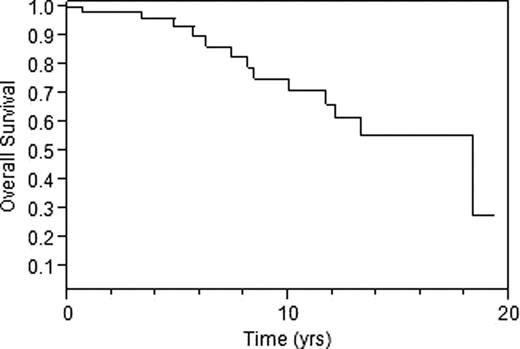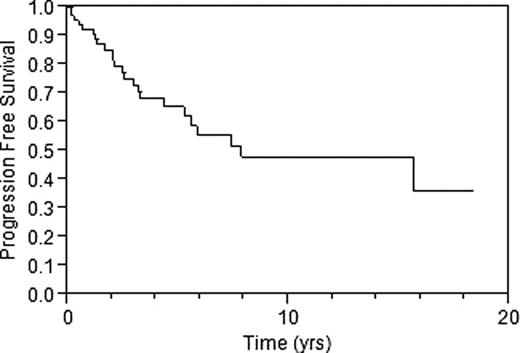Abstract
Abstract 1580
Extranodal Marginal Zone Lymphomas of Mucosa Associated Lymphoid Tissue (MALT) account for approximately 5% of all non-Hodgkin Lymphoma cases. Specific MALT lymphomas are characterized by distinct clinical features, treatment strategies, and outcome, depending on site of the disease. While previous reports have described clinical course and treatment of gastric and pulmonary MALT lymphomas, a paucity of data exist describing primary parotid MALT lymphoma. This is a single institution experience.
Patients with primary parotid MALT lymphoma were identified from the Mayo Clinic Lymphoma Database since 1986. This database includes all consenting patients with lymphoma seen at Mayo Clinic Rochester. Clinical characteristics, treatment, and outcomes were collected. Pathology was reviewed by a lymphoma pathologist; WHO criteria were used for diagnosis. PFS and OS were assessed using the Kaplan-Meier method and Cox proportional hazard model was used to asses the impact of variables on PFS and OS.
Seventy-six consecutive patients with primary parotid MALT lymphoma were evaluated and treated at Mayo Clinic from 1986 to 2010. The median age at diagnosis was 60 years (18–90). 58 (76%) were female. 42 (55.3%) patients had a history of Sjögren's Disease and 51 (67.1%) had a history of autoimmune disorders. 52 (68.4%), 4 (5.3%), and18 (23.7%) had stage I, II, and IV disease, respectively. 2 cases did not have complete staging information. 6 (7.8%) and 2 (2.6 %) had bone marrow and lung involvement, respectively. No patients had GI tract, liver, or CNS involvement. Median estimated OS (overall survival) was 18.3 years and median PFS (progression free survival) was 7.9 years. ALC<0.96 (p=0.0162) were associated with shorter survival. Age, ECOG performance score, stage, LDH, and history of Sjögren's disease were not prognostic for overall survival. The treatment approach and PFS are outlined in the table. For stage I disease, outcomes were excellent with local therapy. The median estimated PFS was 7.9 years with 72% of patients undergoing surgery surviving at 8 years. Patients receiving radiotherapy had an estimated median PFS of 15.7 years and median OS of 18.3 years. In contrast, patients being observed had a median PFS of 5.5 years. The use of systemic therapy with chemotherapy, immunotherapy or in combination was associated with a median PFS of 7.4 years.
Primary parotid MALT lymphoma is strongly associated with Sjögren's disease. This lymphoma is usually limited to the parotid and associated with a favorable prognosis. For limited disease, local treatment with radiation or surgery appears to be an effective treatment options. For extensive disease, both immunotherapy and chemotherapy are efficacious treatments. Further prospective studies and long-term follow up are needed to determine the optimal treatment approaches and efficacy of chemotherapy/immunotherapy regimens.
| Treatment . | n (%) . | Response Rate CR/PR n (%) . | Median PFS . |
|---|---|---|---|
| Surgery | 29 (38%) | 26 (90%)/0 | 7.9 years |
| Radiation | 14 (18%) | 14 (100%)/0 | 15.7 years |
| Observation | 13 (17%) | NA | 5.5 years |
| Chemotherapy/Immunotherapy | 7 (9%) | 7 (100%)/0 | 7.4 years |
| Incomplete Data | 13 (17%) | NA | NA |
| Treatment . | n (%) . | Response Rate CR/PR n (%) . | Median PFS . |
|---|---|---|---|
| Surgery | 29 (38%) | 26 (90%)/0 | 7.9 years |
| Radiation | 14 (18%) | 14 (100%)/0 | 15.7 years |
| Observation | 13 (17%) | NA | 5.5 years |
| Chemotherapy/Immunotherapy | 7 (9%) | 7 (100%)/0 | 7.4 years |
| Incomplete Data | 13 (17%) | NA | NA |
No relevant conflicts of interest to declare.
Author notes
Asterisk with author names denotes non-ASH members.



This feature is available to Subscribers Only
Sign In or Create an Account Close Modal